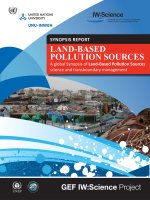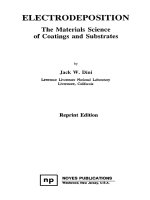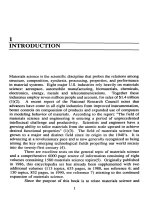CRYSTALLIZATION AND MATERIAL SCIENCE OF MODERN ARTIFICIAL AND NATURAL CRYSTALS pdf
Bạn đang xem bản rút gọn của tài liệu. Xem và tải ngay bản đầy đủ của tài liệu tại đây (34.46 MB, 342 trang )
CRYSTALLIZATION
AND MATERIAL SCIENCE
OF MODERN ARTIFICIAL
AND NATURAL CRYSTALS
Edited by Elena Borisenko
and Nikolai Kolesnikov
Crystallization and
Materials
Science
of
Modern
Artificial
and
Natural
Crystals
Edited by Elena Borisenko and Nikolai Kolesnikov
Published by InTech
Janeza Trdine 9, 51000 Rijeka, Croatia
Copyright © 2011 InTech
All chapters are Open Access distributed under the Creative Commons Attribution 3.0
license, which allows users to download, copy and build upon published articles even for
commercial purposes, as long as the author and publisher are properly credited, which
ensures maximum dissemination and a wider impact of our publications. After this work
has been published by InTech, authors have the right to republish it, in whole or part, in
any publication of which they are the author, and to make other personal use of the
work. Any republication, referencing or personal use of the work must explicitly identify
the original source.
As for readers, this license allows users to download, copy and build upon published
chapters even for commercial purposes, as long as the author and publisher are properly
credited, which ensures maximum dissemination and a wider impact of our publications.
Notice
Statements and opinions expressed in the chapters are these of the individual contributors
and not necessarily those of the editors or publisher. No responsibility is accepted for the
accuracy of information contained in the published chapters. The publisher assumes no
responsibility for any damage or injury to persons or property arising out of the use of any
materials, instructions, methods or ideas contained in the book.
Publishing Process Manager Sasa Leporic
Technical Editor Teodora Smiljanic
Cover Designer InTech Design Team
First published January, 2012
Printed in Croatia
A free online edition of this book is available at www.intechopen.com
Additional hard copies can be obtained from
Crystallization and Materials Science of Modern Artificial and Natural Crystals,
Edited by Elena Borisenko and Nikolai Kolesnikov
p. cm.
ISBN 978-953-307-608-9
free online editions of InTech
Books and Journals can be found at
www.intechopen.com
Contents
Preface IX
Part 1 Structure and Properties of Advanced Inorganic Materials 1
Chapter 1 Crystallographic Observation and
Delamination Damage Analyses for
Thermal Barrier Coatings Under Thermal Exposure 3
Kazunari Fujiyama 17
Chapter 2 Nucleation and Crystal Growth in
Phase Separated Glasses in the Lithium Silicate System 23
G. A. Sycheva
Chapter 3 Elaboration of a Specific Class of Metamaterial:
Glass in Single Crystal 49
Bertrand Poumellec, Matthieu Lancry, Santhi Ani-Joseph,
Guy Dhalenne and Romuald Saint Martin
Part 2 Inorganic/Organic Materials for High Technology 77
Chapter 4 Effect of Amino Acid Additives on
Crystal Growth Parameters and Properties
of Ammonium Dihydrogen Phosphate Crystals 79
P.V. Dhanaraj and N.P. Rajesh
Chapter 5 Topochemical Conversion of
Inorganic–Organic Hybrid Compounds into
Low-Dimensional Inorganic Nanostructures
with Smart Control in Crystal-Sizes and Shapes 99
Deliang Chen
Chapter 6 Synthesis of Cobalt-Zinc
Phosphates Templated by Polyamines 139
Yue Ding, Niu Li, Daiping Li, Ailing Lu,
Naijia Guan and Shouhe Xiang
VI Contents
Part 3 Biomineralization 155
Chapter 7 Unusual Crystal Formation in Organisms -
Exceptions that Confirm Biomineralization Rules 157
Davorin Medaković and Stanko Popović
Chapter 8 Biomimetic and Bioinspired
Crystallization with Macromolecular Additives 185
Il Won Kim
Part 4 Crystal Growth for Health Protection 201
Chapter 9 Freezing Properties of Disaccharide Solutions:
Inhibition of Hexagonal Ice Crystal Growth and
Formation of Cubic Ice 203
Tsutomu Uchida, Satoshi Takeya,
Masafumi Nagayama and Kazutoshi Gohara
Chapter 10 Crystal Growth of Pharmaceuticals from Melt 225
J.S. Redinha and A.J. Lopes Jesus
Chapter 11 Alternative Protein Crystallization Technique:
Cross-Influence Procedure (CIP) 249
Ivana Nemčovičová and Ivana Kutá Smatanová
Part 5 Molecular Crystals 277
Chapter 12 Optical Properties of Molecular Crystals:
The Effect of Molecular Packing and Polymorphism 279
Silvia Tavazzi, Leonardo Silvestri and Peter Spearman
Chapter 13 Parity Violation in Unstirred
Crystallization from Achiral Solutions 305
Marian Szurgot
Preface
Crystal growth is a fundamental phenomenon, which provides the basis for a wide
variety of naturally occurring processes, and an astonishing range of diverse human
activities. This book includes a representative collection of contemporary studies on
crystal growth across various aspects, including; problems concerning crystal growth
in high technology, medicine, pharmacy, and mineralization of marine organisms;
modern techniques developed for crystal growth of inorganic and organic crystals
from melt, solutions, via chemical synthesis, and atmospheric plasma spraying; phase
transitions in solid and liquid states; a particular problem of vitrification and
formation of glass-crystalline composites in complex systems of oxides; interaction
between organic and inorganic materials leading to formation of the advanced class of
inorganic/organic composites; macromolecular crystallization, biomineralization, and
biomimetic crystallization; modern investigative techniques, such as x-ray diffraction
(XRD), scanning electron microscopy (SEM), electron back scattering diffraction
(EBSD), energy dispersive x-ray spectroscopy (EDS), x-ray electron probe
microanalysis (EPMA), IR spectroscopy (IRS), Raman light spectroscopy (RS),
photoluminescence (PL), optical microscopy, thermogravimetric (TG) and differential
thermal analysis (DTA), used to study phase transitions, crystal structure,
morphology, microstructure and properties of the grown materials.
The first chapter Structure and Properties of Advanced Inorganic Materials contains the
studies of thermal barrier ceramic coatings, in particular; yttrium-partially stabilized
zirconium (PSZ) produced by atmospheric plasma spraying; the role of oxide
formation in crack nucleation and growth in PSZ; optical microscopy, SEM, EBSD,
used to study morphology of grain structure, distribution of crystal orientations
(crystallographic texture) and crystal symmetry of the coatings. EDS was applied to
find a correlation between formation of Cr and Al oxides, and crack propagation in the
coating layers.
The second chapter considers the nucleation and crystal growth in phase separated
lithium silicate glasses, and studies the dependences of crystal growth rate in the
lithium silicate systems on SiO
2 content, and heating temperature It has been found
that, - comtrary to the perception -phase separation does not facilitate the conditions
for the formation and growth of crystals.On the contrary, in some cases even retards
the crystal growth process. As a result of the studies, optimum compositions and
X Preface
annealing regimes are recommended for formation of the lithium silicate glass-ceramic
materials for practical applications.
Third chapter deals with Cu-SiO2-GeO2 metamaterials consisting of glass and
crystalline phase, grown by the floating zone technique in the pseudo-ternary system;
Eutectic crystallization, phase composition, microstructure, and optical properties of
the grown materials are studied, and self-organization of a structure is examined,
depending on growth parameters and chemical composition, to find optimal fiber
sizes and filling factor. Crystal state of the materials is studied by x-ray diffraction,
EBSD and Fourier transformation techniques. These results in combination with
EPMA data and analysis of diffusion of the components are used to revise the pseudo-
ternary diagram. A phase boundary of vitrification for a silica glass containing Cu is
demonstrated in graphic form. Shape and crystallography of the etched crystalline
matrix and glass fibers are studied, and increase in a difference of refraction indexes in
the self-organized structure and optical band gap opening caused by fiber etching are
analyzed.
Within the second section of the book Inorganic/Organic Materials for High Technology,
the effect of amino acid additives on crystal growth of ammonium dihydrogen
phosphate (ADP) is studied; a metastable zone width of pure and doped ADP is
measured; a dependence of induction period of nucleation on supersaturation is
investigated; the effect of amino acid additives on crystal growth conditions, including
crystal growth rate is discussed. Powder x-ray diffraction (XRD) experiments confirm
that pure and doped crystals are single phased. High resolution XRD (HRXRD) proves
high perfection of the doped crystals. Some optical, electric and piezoelectric
properties of the pure and doped ADP are studied. These materials are regarded as
promising for application in non-linear optic, and they are used as piezoelectric
crystals.
The following chapter is a study of topochemical conversion from inorganic-organic
hybrid precursors to inorganic nanoplates and nanofilms. Oriented films were
produced from WO
3·H2O and WO3 tungsten oxide nanoplates through dropping–
evaporation process. Topochemical conversion of tungstate-based inorganic-organic
hybrid belts to W2N nanoplates is considered. Average particle size calculated from
XRD patterns is 3.2 nm. TEM images indicate that the nanoplates are composed of
nanocrystals. Application fields of the nanoplates are shown; WO3 nanoplates are used
as a photocatalyst. An amount of O
2 generated when using WO3 nanoplates for visible-
light-induced water splitting is greater than that of commercial WO
3 powders by an
order of magnitude. The enhanced photocatalytic properties should be attributed to
the developed specific surface area and high crystal perfection of the synthesized WO3
crystal nanoplates. WO
3 (α-MoO3) gas sensors were fabricated and tested.
The third chapter of this section describes open-framework structures of metal
phosphates synthesized under hydrothermal or solvothermal conditions in the
presence of linear polyamines used as the structure-directing agents (SDA).
Preface XI
Diethylenetriamine (DETA), triethylenetetramine (TETA) and tetraethylenepentamine
(TEPA) were used to produce CoZnPO
4-IV, CoZnPO4-V and CoZnPO4-VI cobalt-zinc
phosphates. Microporous cobalt-zinc phosphates CoZnPO
4-I, CoZnPO4-II, and
CoZnPO
4-III were synthesized under hydrothermal conditions from gel at the
temperature of 200C with ammonium, ethylenediaminum, and diethylenetriaminum
involved in the crystallization process. The effect of crystallization temperature and
crystallization time on transformations of the cobalt-zinc phosphates is studied;
decomposition of linear polyamines, template molecules, and its effect on
crystallization of zinc-cobalt phosphates is investigated. They have a variety of
potential applications in catalysis, separation processes, and as photo-luminescent
materials.
The third section of this book, Biomineralization, discusses the mineralization of
calcareous organisms. The first chapter considers biomineralization of marine
organisms, various mollusks and oysters. Interaction of calcareous organisms with
metal in seawater is studied by x-ray diffraction (phase analysis) and x-ray
spectroscopy (elemental composition). Ability of the living organisms, in particular,
freshwater and subterranean snails to accumulate dolomite is discussed, and genetic
aspects of biomineralization are tackled.
The following chapter in this section is concerned with calcium-based biominerals;
biomineralization of different families of proteins present in Pacific red abalone
(Haliotis rufescens) and Japanese pearl oyster (Pinctada fucata); The role of
biomacromolecules in the mineralization of calcium carbonate and calcium oxalate;
biomimetic crystallization, which mimics some aspects of biomineralization; role of
natural proteins and peptides in mineralization of calcium carbonate; sources of
amorphous calcium carbonate (ACC) and its role in biomineralization; formation of
ACC in closed pores. Synthetic polymers and peptides are used in mimicked
biomineralization, and calcium oxalate crystals in kidney stones are displayed.
Section four, Crystal Growth for Health protection, includes growth of pharmaceutical
crystals, cryoprotection of living cells, and various techniques of protein crystal
growth.
Within this first chapter, studies focused on the cryoprotective effect of disaccharide
molecules on living cells are discussed. Trehalose and sucrose, which consist of
fructose and glucose rings connected by a glycosidic bond, are natural disaccharide
compounds found in cryoprotectants for living cells. Cryoprotective mechanism of
these substances, considered as controlled by hydrogen bonding between a lipid
bilayer head group and trehalose, is confirmed by Raman spectroscopy. Another
mechanism of protection is inhibition of ice crystal growth in extracellular space.
Cryoprotective mechanism of disaccharide is controlled by the hydration of
disaccharide molecules in water solution. Kinetics of ice crystallization depending on
concentration of trehalose solution and cooling rate of the solution is analyzed.
Electron-microscopic studies of replicas and powder X-ray diffraction analysis were
XII Preface
used to find structure and phase composition of disaccharide and water molecules in
the frozen state. The disaccharide molecules are considered to act as the cell-
impermeable cryoprotectants.
The second chapter deals with growth from melt of pharmaceutical crystals, such as
erythritol, atenolol, pindolol, which are studied by differential scanning calorimetry,
polarized light thermal microscopy, infrared spectroscopy, x-ray diffractometry. The
problems of nucleation, phase transitions caused by solidification of melt, are studied.
The conditions of vitrification and crystallization are found in view of binodal and
spinodal decomposition of a compound in a liquid state. Morphology and
polymorphism of the crystals and mechanisms of crystallization depending on cooling
or heating conditions are considered. The effect of hydrogen bonding on nucleation
and a crystalline structure is analysed by IR spectroscopy, and relationships between
molecular and crystal structures are discussed.
The third chapter is a consistent, representative, and well-illustrated scientific
description of modern alternative techniques used in macromolecular crystallization
of proteins. It considers general principles of macromolecular crystallization and finds
correlations between the nucleation and growth kinetics, and the phase diagram.
Crystallization of a protein in presence of a precipitant is considered on a basis of two-
dimensional solubility diagram. There is a difference between a classical molecular
crystal and a protein crystal; in the former, all the atoms can be described in terms of a
regular lattice, while in the latter a crystal coexists with a fraction of material in a
liquid state. The ways of lowering an energy barrier to crystal nucleation from a
solution are discussed. A role of selective excipients, which might form the self-
assembly in protein crystallization is analyzed. Four well-known crystallization
methods: vapor diffusion, free interface diffusion, batch, and dialysis are compared,
and their advantages and disadvantages are considered. Production of a fine-sized
crystal is regarded as a main drawback of the vapor diffusion technique. The
drawback of free interface diffusion is that it is protein-consuming, since the solution
must be highly concentrated for crystallization. Batch method is more expensive than
the others. Dialysis is not a universal technique, as it does not work with PEG
solutions. Alternative crystallization techniques involve additives, which affect
crystallization. Additive screening, use of cofactors, ligands and heavy-atom ligands
are considered. Salting out is described as the precipitation process in which solute–
solute interactions play an important role. The effect of pH of additives on
crystallization kinetics of proteins is considered.
The final section of this book, Molecular Crystals, is closely connected to the previous
book section in regard to specific features of molecular crystalline structure. However,
in this section the focus is on physical properties, which are of interest for technical
applications. General problem of statistics of the spontaneous breakage of chiral
symmetry in crystallization processes and distribution of left (L) and right-handed (D)
forms in molecules or crystals are studied.
Preface XIII
In the first chapter optical properties of prototypical molecular crystals: 1,1,4,4-
tetraphenyl-1,3-butadiene (TPB), dibenzo[d,d′]thieno[3,2-b;4,5-b′]dithiophene (DBTDT),
N-pyrrole end-capped thiophene/phenyl co-oligomer (TPP) are discussed. Some
methods of crystal growth are considered, as well as the light emission of these
molecular crystals. The general focus is on the UV-visible absorption properties
considered in the framework of the exciton theory of molecular materials. Electronic
and excitonic transitions, exciton polarization, exciton-phonon coupling, the Davydov
splitting of exciton bands of these molecular crystals are discussed. The role of
polymorphism, intermolecular interactions in the transitions is considered using the
experimental data on TPB and DBTDT crystals. TPP is studied to analyze directional
dispersion of the absorption spectra.
The second chapter presents statistics of distributions of enantiomeric excess of
laevorotatory (L) and dextrorotatory (D) NaBrO
3 crystals grown from aqueous
solution. A character of the distribution depending on growth conditions is studied
and a conclusion is drawn on the effect of temperature, supersaturation, crystal
growth rate, a type of crystallizer, handedness of seeds on a relative percentage of L
and D-crystals, and racemates grown from unstirred and stirred solutions. Cloning of
the crystals in stirred solution is studied.
Acknowledgements
It was a pleasure working on this project with the Publishing Process Managers, Ms.
Tajana Jevtic and Ms. Sasa Leporic. I appreciate their competent and timely assistance.
Elena B. Borisenko and Nikolai Kolesnikov
Institute of Solid State Physics, The Russian Academy of Sciences
Russia
Part 1
Structure and Properties of
Advanced Inorganic Materials
1
Crystallographic Observation and
Delamination Damage Analyses for
Thermal Barrier Coatings Under
Thermal Exposure
Kazunari Fujiyama
Meijo University,
Japan
1. Introduction
Recently, as the service condition of high temperature components are becoming severer
and almost beyond its ultimate performance, protective coatings are expected to be
effective solutions to keep the reliability and durability of high efficiency apparatus.
Thermal barrier coatings(TBCs) have been applied to cool down the metal temperature
and to protect damage under thermal exposure of hot gas path components in gas
turbines[1]. As TBCs are used in very severe conditions, thermally induced damage and
material degradation are inevitably induced during service and delamination of coating
layer may occur finally as the result of coalescing multiple lateral cracks and some vertical
cracks after the evolution of oxide layer between top coat and bond coat schematically
shown in Fig.1.
However, the mechanism of damage and degradation is still not clear enough because
there are so many factors affecting the delamination life[2]. Therefore, one objective of
this paper is to focus on how the EBSD observation of thermal exposure samples of TBC
top coatings can be applied to identify the particle morphologies after the plasma
spraying and another is to evaluate the damage process until the delamination of top
coatings.
Optical microscope observation was conducted on laboratory test samples of TBC system
after thermal exposure using electric furnace and for measuring the pore fraction amounts
during the process. SEM observation was also conducted to measure cracks induced by
thermal exposure. It should be noted that the detailed microstructural features of TBC top
coat have not been clearly observed by the conventional optical microscope or scanning
electron microscope (SEM) because those measures cannot reveal the detailed proper
boundaries of top coat splat particles. Electron backscatter diffraction (EBSD) method[3][4]
is expected to be an effective tool for observing the morphologies of such particles, but the
application of EBSD to the TBCs has not been popularized enough due to the difficulties in
preparing the observation surface of TBCs and in identifying the exact crystal systems. We
demonstrate the current status for visualizing the splat morphologies in top coat by EBSD
and depict some problems in applying the technique. EDS(Energy Dispersive Spectroscopy)
Crystallization and Materials Science of Modern Artificial and Natural Crystals
4
analyses and indentation tests are also used as the tools for investigating the sintering of top
coatings and the evolution of TGO(Thermally Grown Oxide) layers. Finally this article
presents some evaluation diagram for the top coat delamination based on the obtained
experimental results.
TBC cracking and delamination modes
Hot gas
Internally
cooling air
Centrifugal force
Temper ature
Substrate
Bond coat
To p c o a t
Internal
cooling
Hot gas
flow
Temperature gradient
Thermal stress evolution
due to the formation of
oxide layerLateral cracks
Compressive stress induced
delamination after extensive
growth of major cracks
Oxide layer
Bond coat
Mechanical
tensile
stress
Oxide
enhanced
thermal
stress
Compressive
thermal stress
Top coat
Top coat vulnerable
to tensile stress
Verti cal cracks
Fig. 1. Schematic illustration for the delamination of TBC in gas turbine blade under
temperature gradient.
Crystallographic Observation and Delamination
Damage Analyses for Thermal Barrier Coatings Under Thermal Exposure
5
2. Specimen preparation [5]
Atmospheric plasma sprayed ceramic coatings are widely used as the thermal barrier
coating (TBC) in high temperature components typically in gas turbine hot gas path
sections. The TBC samples tested here are consisted with three layers: top coat, bond coat
and substrate as shown in Fig.2. The top coat is consisted with Yttria- Partially Stabilized
Zirconia(PSZ). The thickness of top coat region is 1mm, considerably thicker compared with
the commercial TBC system in actual gas turbines.
Top c o at
Bond coat
Substrate
2
0.1
1
19.8
t4.4
Top coat : 8wt%Y
2
O
3
-ZrO
2
(1mm thick); APS(Atmospheric Plasma Spraying)
Bond coat : CoNiCrAlY(100μm thick); LPPS(Low Pressure Plasma Spraying)
Substrate : MA263(2mm thick)
Fig. 2. TBC specimen geometry.
Thermal exposure tests were conducted up to 1000 hours under constant temperature
conditions at 900ºC and at 1000ºC using an electric furnace up to 1000hrs. The specimens
were cut into observation samples with the surface finished with colloidal alumina with
particle diameters as 0.1 to 3 micron meters.
3. Optical microscope observation and measurement of pores and cracks [5]
Figure 3 shows the delamination process exposed at 900ºC. Macro cracks grow laterally in
the top coat just above the bond coat. The surface macro crack is located at the interface
between top coating and bond coat besides at the mid section crack is located above the
bond coat within top coat. Fig.4 shows the cross section exposed for 50hours at1000ºC. The
delamination was clearly found in this case.
Figure 5 shows optical microscope observation of top coat at the region near the bond coat.
Reduction of the area by pores was observed for samples after thermal exposure compared
with as-sprayed samples despite of the non-monotonic trend with exposure time. Fig.6
shows the traced pore image for image processing based on optical microscope photos. Area
fractions of pores were obtained from the area ratio of pores (black area) to the observed
area.
Figure 7 shows the trend of area fraction of pores against thermal exposure time. Reduction
in area fraction of pores was observed at the initial stage of heating but the decreasing trend
was not monotonic. The area fraction of pores showed similar levels exposed at 900°C for
500h and at 1000°C for 75h.
Crystallization and Materials Science of Modern Artificial and Natural Crystals
6
Top c o at
Bond coat
Substrate
A
A
(A-A : Observed portion)
500μm
(a)As sprayed
500μm
(b)900ºC 100h
500μm
(c)900ºC 300h
Crystallographic Observation and Delamination
Damage Analyses for Thermal Barrier Coatings Under Thermal Exposure
7
500μm
(d)900ºC 1000h
Fig. 3. Optical microscope observation of the cross section at 900 ºC exposure tests.
Fig. 4. Optical microscope observation of the cross section at 1000 ºC-50h exposure test.
As sprayed
Exposure hours at 900˚C
100 500 1000
Exposure hours at 1000˚C
50 75 100
Fig. 5. Optical microscope observation of top coat.
500μm
Crystallization and Materials Science of Modern Artificial and Natural Crystals
8
As sprayed
Exposure hours at 900˚C
100 500 1000
Exposure hours at 1000˚C
50 75 100
Fig. 6. Pore area trace of optical microscope image in top coat.
0
10
20
30
40
50
0 500 1000
Area fraction of pores,%
Ex
p
osure time,h
900˚C
1000˚C
Fig. 7. The trend of area fraction of pores in top coat against exposure time.
4. SEM/EBSD observation and measurement of crack growth trend [5]
SEM observation was conducted using the thermal field-emission scanning electron
microscope mainly used for investigating crack morphologies. Observed cracks were traced
manually and then processed by image processing software to measure crack length. TGO
layer was investigated using EDS system of SEM to identify the elements of oxides.
Crystallographic Observation and Delamination
Damage Analyses for Thermal Barrier Coatings Under Thermal Exposure
9
EBSD observation was conducted using Tex SEM Laboratory OIM 4.6 system attached to the
SEM. IPF(Inverse Pole Figure) maps were obtained from the position adjacent to the bond
coat within top coat(bottom region), middle of top coat thickness(middle region) and near
surface region of top coat(top region). The tentative crystal system for EBSD observation
was ZrO
2
cubic system because of the easiness of observation of particle morphologies
though PSZ has commonly tetragonal system. It should be noted that the EBSD equipment
has the limitations to characterizing the tetragonal system from the cubic system for the
subject top coating PSZ, requiring further development of the technique to identify the
tetragonal system clearly and easily.
Figure 8 shows the matching of SEM image and EBSD IPF maps near bond coat for as-
sprayed samples. The splat particle morphologies were clearly observed by IPF maps, which
cannot be obtained from the SEM image. The splat morphologies are classified into two
typical groups. One is large granular type particles which might not be melted completely at
the spraying process, and the other is the cluster of small columnar particles which might be
formed by crystallization from completely melted particles. Cracks are found to be affected
by splat microstructures after crystallization completed.
Figure 9 shows the matching of SEM image and IPF maps from bottom to top region of top
coat for samples exposed at 900°C for 500h. Though there is no significant difference in
crystallographic features and crack morphologies in test samples and locations, subsequent
crack growth and reduction of pores can be seen by comparing with as-sprayed sample
shown in Fig.8.
Figure 10 shows the matching of SEM image and IPF maps near delamination portion
samples for 1000ºC/500h exposed sample. Larger cracks can be found by comparing with
Figs.8 and 9.
Figure 11 shows IPF maps at higher magnification for typical crack morphologies. There are
three major cracking patterns. The first is the interface cracking between large granular
particles and the cluster of small columnar particles, the second is the interface cracking
along larger granular particles which is often perpendicular to thickness direction of coating
and the third is the transgranular cracking across the cluster of small columnar particles.
The cracking orientation seems almost perpendicular to crystal growth direction at the
columnar small particle regions. Those cracks are thought to be introduced during cooling
process after crystallization was completed. For heated samples cracks are thought to grow
from initially introduced cracks during spraying process and increasing in number at
successive exposure test. There is no apparent dependence of crack morphologies on the
position toward the thickness direction of top coat.
Figure 12 shows the comparison of IPF maps before and after indentation tests for as-
sprayed sample. Indentation tests were conducted by 500mN load. Cracks or pores were
emanated from the corner of the diamond shaped indentation and showed the apparent
tendency that cracks developed along the intergranular path along relatively larger splat
particles and the extensive drop out occurred at the small particle zones. This result
suggested the very low resistance at small particle (or amorphous) zones and particle
boundaries but relatively higher resistance at larger particles. Fig.13 shows the local
zoomed up IPF maps with SEM image of green circle region in Fig.12 before and after
indentation test. This map clearly indicated the transgranular cracking path from the
indentation corner and coalesced with the pre-existing crack across relatively large
particles.
Crystallization and Materials Science of Modern Artificial and Natural Crystals
10
(a )Observed portion(SEM ima ge)
(b)Inverse pole figure m a p
100μm
10μm
10μm
Fig. 8. Matching of SEM observations and IPF map of as-sprayed sample.
Crystallographic Observation and Delamination
Damage Analyses for Thermal Barrier Coatings Under Thermal Exposure
11
(a) Location of observation (b) Bottom portion
Fig. 9. Matching of IPF maps and SEM image for the sample exposed at 900ºC for 500h.









